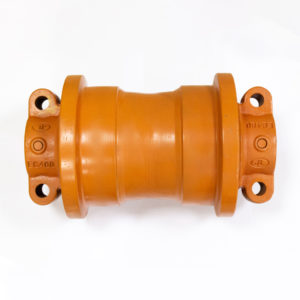Excavator track links are typically manufactured using high-strength steel alloys. The specific type of steel can vary depending on the manufacturer and the desired properties of the track links.
Some commonly used materials for manufacturing excavator track links include:
Carbon Steel: Carbon steel is a widely used material in track link manufacturing. It offers good strength, durability, and cost-effectiveness. Different grades of carbon steel may be used depending on the specific requirements of the excavator model.
Boron Steel: Boron steel, also known as alloy steel, is often used in the construction of track links. It is known for its exceptional hardness, strength, and wear resistance. Boron steel track links are designed to withstand demanding working conditions and have a longer lifespan compared to standard carbon steel links.
Heat-Treated Steel: Heat-treated steel is a type of steel that undergoes a controlled heating and cooling process to enhance its mechanical properties. This process improves the strength, hardness, and wear resistance of the track links, making them more durable and suitable for heavy-duty applications.
Manganese Steel: Manganese steel, also known as Hadfield steel, is a type of steel alloy that contains high levels of manganese. It offers excellent toughness, impact resistance, and work-hardening properties. Manganese steel track links are often used in applications where resistance to wear and impact is crucial.
The choice of material depends on various factors, including the excavator’s operating conditions, load capacity requirements, and desired durability. Manufacturers select materials that provide the necessary strength, toughness, and wear resistance to withstand the stresses and abrasive environments encountered during excavator operation. It’s worth noting that different sections of the track link, such as the cleats or treads, may use specialized materials or coatings to enhance their specific functions, such as providing traction or reducing wear.
What is the purpose of an excavator track link?
The purpose of an excavator track link is to form part of the undercarriage system that supports and propels the excavator. It is a crucial component that connects the track shoes or pads, enabling the excavator to move over various terrains and perform tasks efficiently.
The track link plays several important roles:
Weight Distribution: The track links, along with other undercarriage components, help distribute the weight of the excavator over a larger surface area. track and rollers This reduces the ground pressure exerted by the machine, preventing it from sinking into soft or unstable ground. Effective weight distribution enhances stability and allows the excavator to operate on different terrains.
Traction and Grip: The outer surface of the track link typically features treads, cleats, or other patterns that provide traction and grip. The track links make contact with the ground, allowing the excavator to generate traction and move forward, backward, or turn with stability. The grip provided by the track links enables the machine to operate on challenging surfaces such as loose soil, mud, or inclines, without slipping or losing control.
Flexibility and Mobility: The interconnected track links enable the excavator to move smoothly and efficiently. The continuous track system allows for greater flexibility and mobility compared to wheeled machines. The tracks conform to the terrain, providing stability and preventing excessive ground disturbance. This flexibility allows the excavator to access different work areas and navigate tight spaces more easily.
Load-bearing Capability: The track links, along with the other undercarriage components, bear the weight of the excavator and any additional loads it carries. They are designed to withstand heavy loads and provide structural integrity, ensuring safe and efficient operation during lifting, digging, or material handling tasks.
Absorption of Shock and Vibration: During operation, the track links, along with other undercarriage elements, absorb shocks and vibrations generated by the machine’s movement and interaction with the ground. This absorption reduces the impact on the operator, the machine, and the materials being handled, resulting in smoother operation, improved operator comfort, and reduced stress on the excavator’s structural components.
In summary, an excavator track link serves as a crucial component in the undercarriage system, providing weight distribution, traction, flexibility, load-bearing capability, and shock absorption. It contributes significantly to the stability, maneuverability, and overall performance of the excavator.
